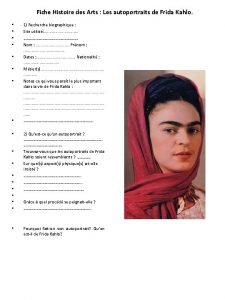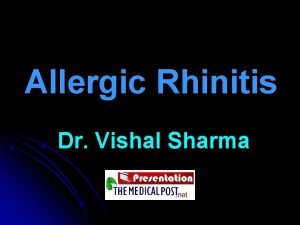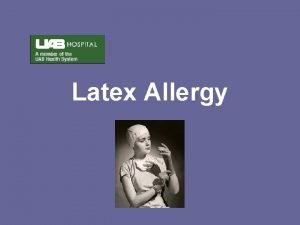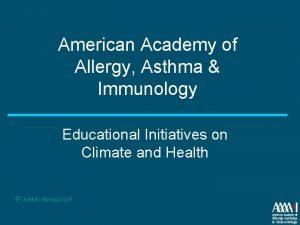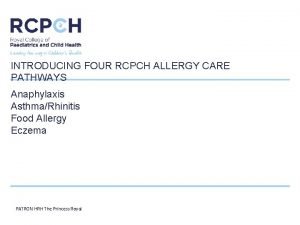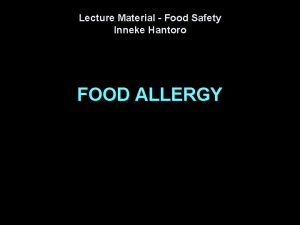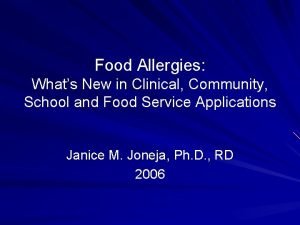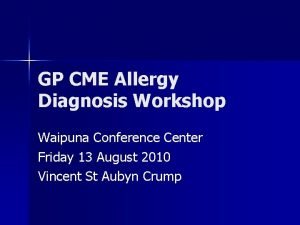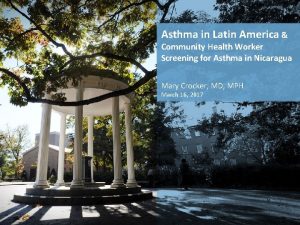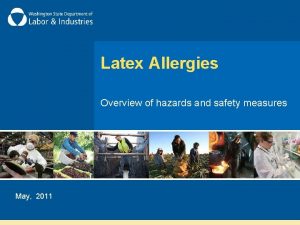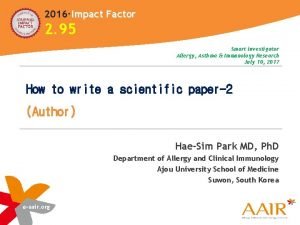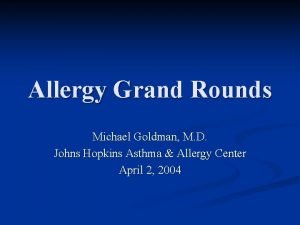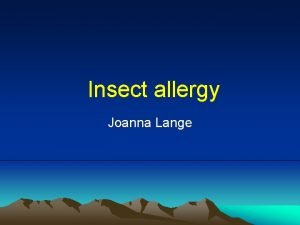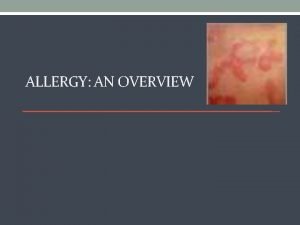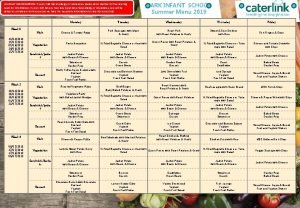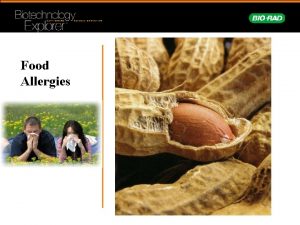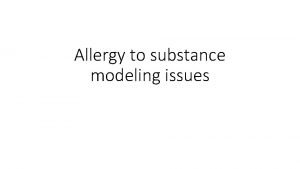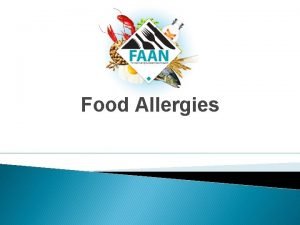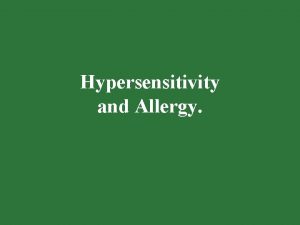Survey on parents awareness on allergy in infants

















- Slides: 17

Survey on parents’ awareness on allergy in infants Dr. Alfred Tam Specialist in Paediatrics MBBS( HK), FRCP (Edin. ), FRCP (Lond. ), FRCP (Glasg. ), FHKCPaed, FHKAM (Paediatrics) 22 nd November 2005

WHO / WAO meeting on the Prevention of Allergy and Allergic Asthma, Geneva, 8 -9 January 2002 l Over 20% of the world population is atopic l Asthma occurs in 10 -15% of the paediatric population l Asthma affects approximately 150 million people worldwide

Allergic disease are very common among children in Hong Kong The prevalence of allergic diseases among children is increasing in Hong Kong (But not asthma) Prevalence (%) Asthma Life time Rhinitis Life time Eczema 2000 -2001 (n =4448) 1994 -1995 (n=3618) p-value 7. 9 7. 8 0. 87 42. 4 38. 9 <0. 01 30. 7 28. 1 0. 01 Reference: Lee SL, Wong W & Lau Y. L. Pediatric Allergy and Immunology 2004, (15) 72 -78

Hong Kong ranked second highest asthma prevalence in the Asia –Pacific region Hong Kong Malaysia Singapore Taiwan Prevalence(%) of symptoms Asthma ever 11 10. 3 20. 7 9 Wheeze ever 20 12. 5 18. 6 - Reference: Wong GWK, Leung TF & Fok TF, Paediatric Respiratory Reviews 2004, (5) S 163 -S 169

Most common food allergens infants l in Most common foods provoking food allergy in infants: (1) Cow’s milk (2) Egg (3) Peanuts l Skin problem ( Eczema, skin rash) is the most common symptom of hypersensitivity 參考文獻: World Allergy Organization, viewed 11 November 2005, < http: //www. worldallergy. org/prefessional/allergic_disease_center/f oodallergy> ; Sampson H. A. Allergy 2005; 60(S 79): 19 -24

Allergy March Sensitization and allergic symptoms in early childhood lead to an increased risk of allergic disease in adulthood (Sarrinen U. M. & Kajosaari 1995; Bergmann RL et al. 1998 ; Host A 2001 ; Spergel JM & Paller AS 2003 ; Rhodes et al. 2001; Sampson H. A. 2003 ; Halken S 2004; Wickman M. 2005; Hahn E. & Bacharier L. B. 2005)

Mothers’ alertness on managing hypersensitivity symptoms in infants are not high Can you successfully manage with your babies’ hypersensitivity symptoms? n = 176

Mothers’ alertness on managing hypersensitivity symptoms in infants are not high n = 114 For those 66% who cannot and temporarily managed their babies’ hypersensitivity symptoms, nearly 50% of them were not stressed because they did not recognize it’s a big problem or they believed symptoms will gradually disappear with ages

Mothers’ awareness on the risk factor for allergic symptoms are high but they are ignorant on prevention strategies Most 66% of the mothers could identify food allergy as a risk factor for these allergic symptoms and believed that food selection during the first year is crucial l However, nearly 40% of them did not recognize breastfeeding or HA formula can protect babies’ immature immune system l Identify 2 risk factors leading to baby’s hypersensitivity reactions Environmental factors Food allergy Are you aware of breastfeeding or HA formula feeding can prevent over-sensitization to babies’ immature immune system?

Breastfeeding: The best choice for infants • Avoid over sensitization to immature immune system in infants • Provide optimal nutrition to suit your baby‘s need

The gut immune system is not yet mature in newborn and they are prone to over react with foreign intact proteins Gut immune system Mouth Liver Large Intestine Stomac h Small intestine Sampson H. A. J Allergy Clin Immunol 2003; 111: S 540 -7

Proteins in HA formula are refined to smaller particles to prevent overreaction of the immature infant immune system and reduce the allergy risk Reference: Hays T & Wood R. A. Arch Ped adolesc med 2005: 159: 810 -816; Exl BM et al. Eur J Nutr 2000; 39: 145 -146 Exl BM et al. Eur Nutr 2000; 39: 145 -146

Conclusion Food allergy during the 1 st year of infancy in HK is common l Early dietary prevention is crucial to strengthen babies’ immune system and significantly reduced the onset of allergic diseases in infants, childhood and adulthood l Breastfeeding is the best for babies. H. A. formula can be considered for babies if breastfeeding is not possible l

Thank you!

References Bergmann RL et al. 1998, ‘ Atopic Dermatitis in early infancy predicts allergic airway disease at 5 years’, Clinical and experimental Allergy, vol. 28, pp. 965 -970 Exl BM et al. 2000, ‘ Improved general health status in an unselected infant population following an allergen reduced diet-intervention programme: Results until 2 years’, J Paediatr Gastroenterol Nutr, vol. 31 (Suppl 2), pp. 27 Hahn EL, Bacharier LB 2005, ‘ The Atopic March: The Pattern of Allergic Disease Development in Childhood’, Immunol Allergy Clin N Am, vol. 25, pp. 231 -246 Halken S 2004, ‘ Prevention of allergic disease in childhood: clinical and epidemiological aspects of primary and secondary allergy prevention’, Pediatr Allergy Immunol, vol. 15 (Suppl. 16), pp. 9 -32 Hays T & Wood RA 2005, ‘ A systematic review of the role of hydrolyzed infant formulas in allergy prevention’, Arch Pediatr Adolesc Med, vol. 159, pp. 810 -816

References Host A 2001, ‘ Primary and secondary dietary prevention’, Pediatr Allergy Immunol, vol. 12 (suppl 14), pp. 78 -84 Lee SL. , Wong W, Lau YL 2004, ‘ Increasing prevalence of allergic rhinitis but not asthma among children in Hong Kong from 1995 to 2001 (Phase 3 International Study of Asthma and Allergies in Childhood)’, Peditar Allergy Immunol, vol 15, pp. 72 -78 Rhodes H et al. 2001, ‘ Early life risk factors for adult asthma: A birth cohort study of subjects at risk’, J Allergy Clin Immunol, vol. 108, pp. 720 -725 Saarinen UM & Kajosaari M 1995, ‘ Breastfeeding as prophylaxis against atopic disease; prospective follow-up study until 17 years old’ , Lancet, vol. 346, pp. 10651069 Sampson HA 2003, ‘ Food allergy’, J Allergy Clin Immunol, vol. 111, pp. S 450 -457

References Sampson HA 2005, ‘ Food allergy- accurately identifying clinical reactivity’, Allergy, vol. 60 (Suppl. 79), pp. 19 -24 Spergel JM & Paller AS 2003, ‘ Atopic dermatitis and the atopic march’, J Allergy Clin Immnol, vol. 112, pp. S 118 -127 Wong GWK, Leung TF & Fok TF 2004, ‘ ISAAC and risk factors for asthma in the Asia- Pacific’, Paediatric Respiratory Reviews, vol. 5 (Suppl A), S 163 -S 169 Wickman M 2005, ‘ When allergies complicate allergies’, Allergy, vol. 60 (Suppl. 79), pp. 14 -18 World Health Organization 2003, Prevention of Allergy and Allergic Asthma, WHO Document Production Services, Geneva, Switzerland
 Cvs privacy awareness training answers
Cvs privacy awareness training answers Tableau frida kahlo mes grand parents mes parents et moi
Tableau frida kahlo mes grand parents mes parents et moi Parents parents
Parents parents Histoire des arts frida kahlo
Histoire des arts frida kahlo 叫叫abcd
叫叫abcd Transverse nasal crease removal cream
Transverse nasal crease removal cream Latex allergy rash pictures
Latex allergy rash pictures American academy of allergy asthma and immunology 2018
American academy of allergy asthma and immunology 2018 Rhinitis allergy
Rhinitis allergy Allergy
Allergy Oral allergy syndrome
Oral allergy syndrome Maia brewerton
Maia brewerton Penicillin allergy cme
Penicillin allergy cme Allergy rates
Allergy rates Latex allergy
Latex allergy Allergy asthma immunol res impact factor
Allergy asthma immunol res impact factor Allergy
Allergy Anegdotal
Anegdotal



